Our two week Spain road trip itinerary will take you on an epic World Heritage tour to explore the very best highlights of Madrid, Castilla y León, Extremadura and Andalucía.
Spain’s coasts and beaches are magnets for holidaymakers, but it’s the country’s heartland that hooked us. It’s packed with some of Europe’s most impressive cathedrals, castles, fortresses, palaces, museums, galleries, ancient ruins, tombs and medieval cities.
We’ve handpicked the best of these sites and experiences and weaved them into an incredible two week Spain road trip of culture and history that loops from Madrid through central and southern Spain.
It’s a jaw dropping journey of almost 2,000 kilometres. You’ll discover Spain’s long and fascinating history, remarkable architectural legacy, and distinctive culture and cuisine.
It’s an ambitious itinerary, and yet our own two weeks in Spain flew by far too quickly, much of it draped in a dense, energy-sapping heat (something to bear in mind if travelling during the height of summer).
No question though, we want to do it all again. We reckon you will too.
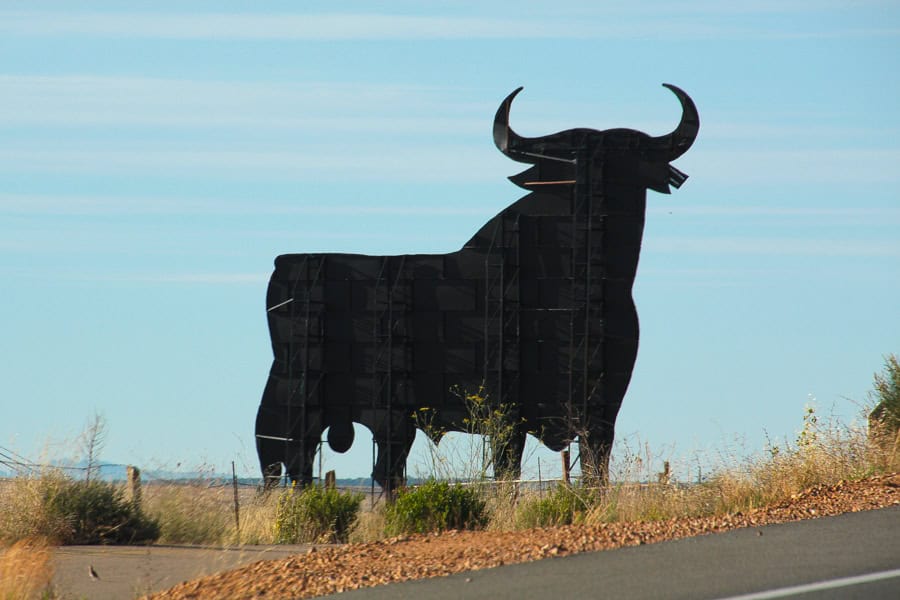
Spain Road Trip Itinerary – Snapshot
Start & Finish: Madrid, Spain.
Distance: Around 1,800km (1,120 miles).
How long do I need? You’ll need two weeks to complete this entire loop from Madrid, through Castilla y León, Extremadura and Andalucía.
Overnight stops: 2 nights in Madrid, 2 nights in Salamanca, 2 nights in Seville, 2 nights in Ronda, 2 nights Granada, 2 nights in Córdoba, and 1 night in Toledo.
What’s in this post?
What’s the Route?
Planning a Spain Road Trip Itinerary
– Getting to Madrid
– Best Time to Visit Spain
– Accommodation in Spain
– Driving in Spain
– Car Hire in Spain
2 Weeks in Spain Road Trip Itinerary
– Day 1 – Madrid
– Day 2 – Madrid
– Day 3 – Madrid to Salamanca via Ávila and Segovia
– Day 4 – Salamanca
– Day 5 – Salamanca to Seville via Mérida
– Day 6 – Seville
– Day 7 – Seville to Ronda via the Pueblos Blancos
– Day 8 – Ronda (and a Wine Tour)
– Day 9 – Ronda to Granada via the Dolmens of Antequera
– Day 10 – Granada
– Day 11 – Granada to Córdoba
– Day 12 – Medina Azahara and afternoon in Cordoba
– Day 13 – Córdoba to Toledo
– Day 14 – Toledo to Madrid (and Departure)
This post contains affiliate links. If you choose to buy through these links we may earn a small commission at no extra cost to you, which helps us to keep Two for the World running. Many thanks for your support!
What’s the Route?
Our 1,800 kilometre Iberian circuit packs 5,000 years worth of history into two incredible weeks. You’ll explore Spain’s buzzing capital, Madrid, before skirting the southern part of the Castilla y León region, then heading into southern Spain through the regions of Extremadura and Andalucía and looping back to Madrid.
Along the way you’ll get to marvel at some of Spain’s tourism heavyweights, including Madrid, Salamanca, Seville and Granada, while also discovering some of its more understated gems like Segovia, Ávila, Mérida, Ronda, Córdoba and Toledo.
It’s a two week journey that packs a huge amount of sightseeing between a grand sunset over Madrid’s Versaille-like Royal Palace on our first day and the divine golden glow of dawn over Toledo on the final morning.
During that time you’ll see a host of incredible World Heritage sites, including Seville’s Alcázar, Granada’s Alhambra, and Córdoba’s Mezquita. You’ll get to walk some of Spain’s grandest boulevards, explore its medieval alleys, marvel at its incredible architecture, learn some of its story, and get a taste for (or if you’re like us, become addicted to) Spanish cuisine and vino.
At times it’s a full on road trip, but by the end we guarantee you won’t want to leave.
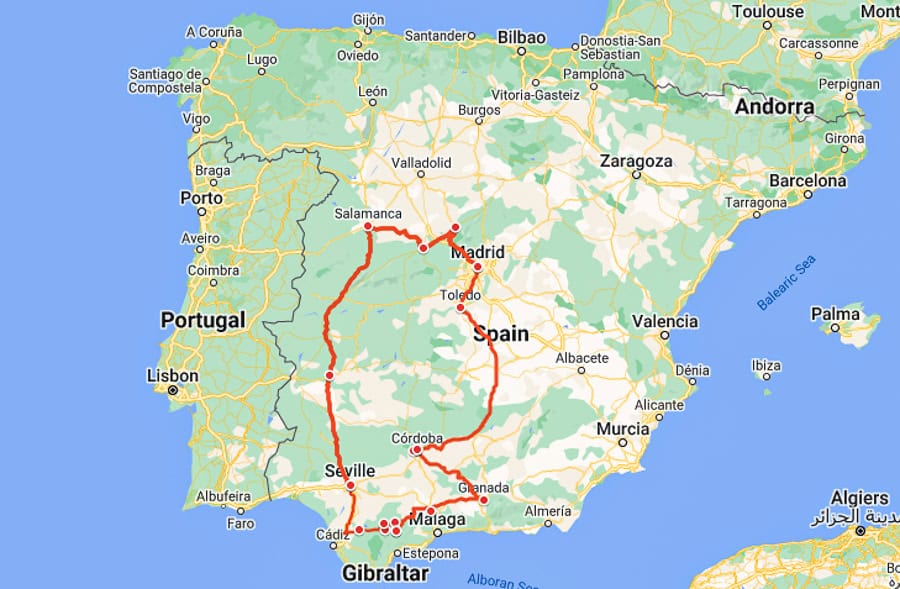
Planning a Spain Road Trip Itinerary
Getting to Madrid
As Spain’s capital, it’s not surprising Madrid has excellent transport connections. Adolfo Suárez Madrid-Barajas Airport has international flights from across Europe and the world., and it’s well linked to the city centre by metro, bus and train.
Madrid is also a major hub for Spain’s AVE high-speed trains, connecting to cities like Barcelona, Seville, and Valencia from Atocha and Chamartín stations.
If you’re coming by road, Madrid’s highways connect to all major parts of Spain and neighbouring countries.
Best time to Visit Spain
I’ve got vivid memories of charging up a cobbly hill in Mérida in 42 degree heat – hungry, thirsty and conscious that siesta was nearly upon us, but desperate to squeeze in a visit to the Roman funeral site and 2nd century house before I collapsed from exhaustion.
It’s fair to say, summer in Spain is not for the faint hearted. I’ll be honest and say if I had my time again, I would avoid visiting during the hottest months between June and August when temperatures, particularly in southern Spain, can be oppressive.
The best time to visit Spain is during the Spring months of April and May, and the Autumnal months of September and October. During these months, the weather is mild and pleasant, ideal for exploring cities and outdoor activities without the intense summer heat.
A visit to Spain in Winter has the benefit of less crowds and relatively mild weather, although this really does depend on where you are. As a general rule the north of Spain and any mountainous regions tend to be colder and wetter at this time of year, while the southern and coastal areas still enjoy a relatively mild climate.
Accommodation in Spain
It’s normally our preference on road trips to pick a handful of bases that allow us to explore major cities and enjoy day trips to surrounding areas.
This Spain travel itinerary is a little different in that we are covering quite a lot of ground, and some days there are long drives, so we’re moving more often and our longest stay is just two nights.
While there are obvious downsides of this approach, it does have the added benefit of allowing us to sample the after-dark scene of more places, and experience them when many of the daytrippers have departed.
Overall, we found it fairly easy to find accommodation in Spain at our target mid-range budget in all the places we visited, but there’s also a wide variety of stays to be had.
We’ve seen palaces built atop Roman ruins turned into luxury stays that tastefully preserve their archaeological legacy. There are boutique hotels with fabulous rooftop bars, terraces, pools and spas. And there are fancy hotels with Michelin starred restaurants, funky hostels with comfy dorms, and an abundance of homestays and fully equipped apartments.
Driving in Spain
We found driving in Spain to be generally quite easy, thanks to well-maintained roads and a comprehensive highway system. The autopistas (motorways) are fast and efficient, although some have tolls.
Road signs are in Spanish, and speed limits are strictly enforced, with urban areas limited to 30-50 km/h and highways to 120 km/h.
Some cities and larger towns have low emission and pedestrian only zones, and some places restrict vehicle access to residents and hotel guests only. These are all things that you may need to check with your car hire provider or chosen hotel in advance of your trip.
Driving in city centres, particularly historic areas, can be challenging, especially if you opt for a larger car (something we tend to avoid). The often steep, winding, and narrow laneways can be stressful to navigate, and for this reason we try to find hotels with parking outside historic centres, or use secure parking garages located on major roads with easy access.
Car Hire in Spain
You’ll need a car for this 2 week Spain itinerary. Unless you plan to bring your own wheels, we recommend you book your car hire in Spain well in advance to get the best rates and ensure you get the vehicle class you want.
We’ve always found the best deals at DiscoverCars and they’re our go-to car hire provider these days, with great rates and free cancellation should your plans need to change.
Booking in advance will get you the best rates and widest choice of vehicle.
2 Weeks in Spain Road Trip Itinerary
Day 1 – Madrid
Highlights: Madrid Walking Tour | Tapas and Wine Tasting Tour
Total driving distance: No driving today, you’ll pick up a hire car on Day 3 of this two week Spain itinerary.
Overnight: Madrid
We’re starting our Spanish fiesta in Spain’s capital, Madrid, a large and sprawling city criss-crossed with lovely boulevards, beautiful plazas, Baroque architecture, relaxing parks, vibrant nightlife and an enviable foodie scene.
Madrid’s Barajas International Airport lies around 15km northeast of the city and is well served by public transport. Metro, trains, express buses, rideshares, taxis and shuttle services are all available.
If you want to organise a private transfer ahead of time, you can check prices at Kiwitaxi.
Madrid Walking Tour
Day 1 for us is all about orientation, so try to arrive as early as possible so you can drop your bags and head out on walking tour. We always try to do a walking tour for any new city we visit as it’s a great way to get your bearings and learn about the city from a local guide.
The Welcome to Madrid Guided Walking Tour gets great reviews and is led by a Madrid-based guide. Allow for 2.5 hours to cover the old town and some of city’s architectural highlights like Plaza Mayor, Plaza de la Provincia, and the Royal Palace.
During that time you’ll learn all about the city’s fascinating history and culture, while getting some great insights on where to eat, drink and shop like a local.
Of course if you don’t fancy walking around Madrid, you can always spend a few hours on the hop-on-hop-off bus for your introduction to the city.
By now you’ll be feeling more at home, and since you’ve had a busy day already, why not make like a local and head back to your hotel for a brief siesta to recharge your batteries ahead of tonight’s foodie extravaganza.
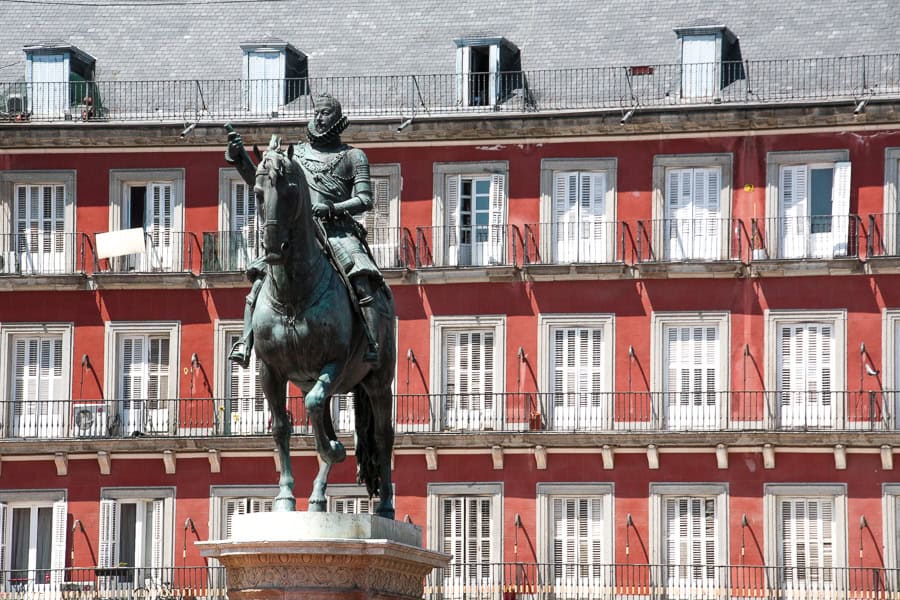
Tapas and Wine Tasting Tour
Without any doubt we travel through our bellies, and there’s nothing quite like getting to know a city than by exploring its food and wine.
Madrid is renowned for great food and vibrant nightlife, so we recommend spending your first night here enjoying a tapas and wine tasting tour. Not only is it a great way to meet other travellers, but you’ll get some valuable insights into the art of enjoying tapas in Spain, and some great tips on where to eat and drink in the Spanish capital and beyond.
You’ll be spoilt for choice with food and wine tours, but this Gourmet Madrid Tapas and Wine Tasting Tour offers small group tours (max 12 people), gets great reviews from other travellers and has free cancellation up to 24 hours before the tour.
Where to Stay in Madrid
Like any major capital city, Madrid has a wide range of accommodation options at pretty much all price points across a diverse range of neighbourhoods.
Whether it’s the central convenience of Sol, the cool, bohemian vibes of Malasaña, the tapas and nightlife of La Latina, relatively quiet Retiro, vibrant Huertas, or upscale Salamanca, Madrid has you covered.
We opted to stay in the Argüelles neighbourhood at Suites Viena, not far from Plaza de España, and only a short walk from the Royal Palace. We loved the convenient location, included breakfast, and that the spacious room included a small kitchenette.
The following options also get consistently good reviews:
- Good value: Hostal Lauria – central location | friendly staff | clean, comfy rooms
- Mid-range: Woohoo Rooms Boutique Luna – modern | comfy rooms | close to everything
- Indulge: Wellington Hotel & Spa Madrid – great location | outdoor pool | luxurious rooms | Michelin-starred restaurant
Day 2 – Madrid
Highlights: Prado Museum | Parque del Buen Retiro | Royal Palace
Total driving distance: No driving today, you’ll pick up a hire car tomorrow.
Overnight: Madrid
Today is all about delving a little deeper into the Spanish capital, enjoying more of its incredible architecture, uncovering more of its history, taking in some of the excellent art that’s on offer, and perhaps sampling more tapas and vino.
After fortifying yourself with coffee and churros (a must if you don’t mind a sweet breakfast), enjoy a stroll through Plaza de España before heading up to Principe Pio’s Parque de la Montaña for nice views across the city and a visit to the 2,000-year-old Temple of Debod, transported to Spain from Egypt in the early 1970s.
It’s just a 15 minute stroll from here down to Madrid’s wonderfully Baroque Royal Palace, one of the largest in Europe. Be sure to walk via lovely Sabatini Garden for nice views of the palace before heading inside to explore some of the lavish interior.
It’s well worth putting a couple of hours aside for a Royal Palace Skip-the-Line Guided Tour so you can bypass the queues and see some of the best rooms and art the palace has to offer. Consider booking ahead as it’s a popular spot to visit.
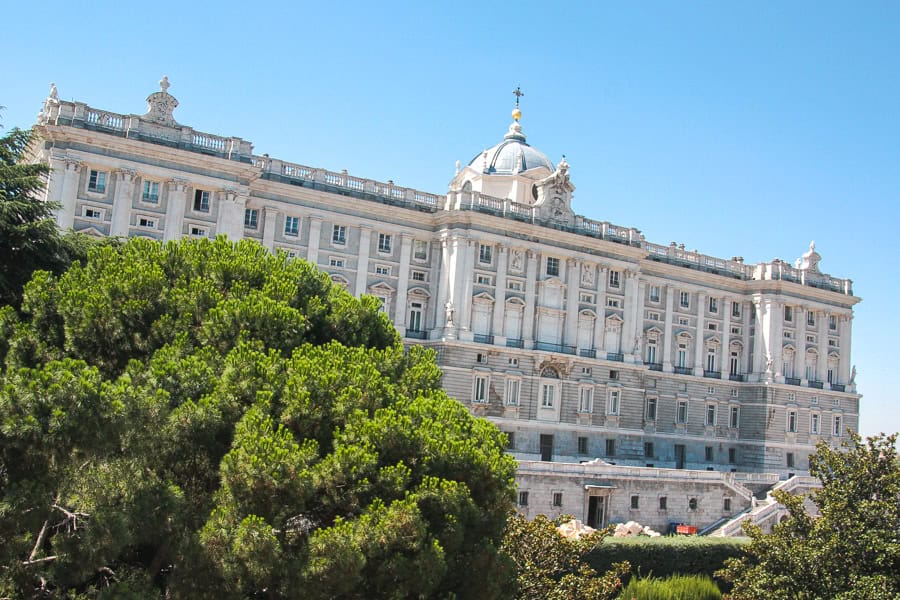
It’s a short 5-10 minute walk to our lunch spot at Mercado de San Miguel, but on the way be sure to pause and admire the grand, but surprisingly new Catedral de la Almudena, and the last remnants of Madrid’s 9th century Muslim Walls.
While it may be slightly touristy, Mercado de San Miguel is a great spot to grab some tapas while enjoying some very welcome shade.
After lunch, take a stroll through beautiful Plaza Mayor, and then up Calle Mayor towards Puerta del Sol, before heading on towards Madrid’s world famous ‘Golden Triangle of Art’.
While Museo del Prado is the most famous of Madrid’s art museums, with its expansive collection of European art spanning the likes of Goya, Hieronymus Bosch, Rubens, Rembrandt and Titian, art lovers really are spoilt for choice in this city.
If your tastes are more contemporary, then the Reina Sofía might be more your thing, with Salvador Dalí, Picasso, Bacon and Miró on display, to name just a few.
If you want something more intimate, then maybe consider the Thyssen-Bornemisza Museum, with its broad-ranging 13th to 17th century collection that includes the likes of Van Gogh, Dalí, Rembrandt and Renoir in a more compact space.
You’ll need at least a couple of hours to get a taste of any of these incredible institutions, and like most things, it’s a good idea to book in advance if you can. Get Your Guide has a good variety of options ranging from skip the line entry to guided tours.
You’ll no doubt be ready for some fresh air after your art fix, so why not head across to nearby Parque El Retiro for a wander. It’s an easy place to lose yourself for an hour or two with its welcome shade, picturesque lake, manicured lawns, fountains and sculptures.
While here keep your eyes peeled for Madrid’s lovely 19th century Crystal Palace (Palacio de Cristal), and the rare sculpture of the devil (El Ángel Caído) that’s said to sit 666 metres above sea level. It’s worth exiting the park on the north side near the Puerta de Alcalá so that you can check out the striking Palacio de Cibeles on the way back to your hotel.

After freshening up at the hotel it’s time to head out for one final taste of Madrid’s nightlife (just remember, it’s an early start tomorrow). For a night of tapas and bar hopping, you can’t really beat the La Latina area. Consider Malasaña if you want an evening of bohemian bars and cool restaurants, or for something a little livelier, try Huertas or Chueca.
Day 3 – Madrid to Salamanca via Segovia and Ávila
Highlights: Roman Aqueduct of Segovia | Alcázar de Segovia | UNESCO old towns of Segovia and Ávila | Ávila City Walls
Total driving distance: appx. 275 km (170 miles)
Total driving time: appx. 3.5 hours
Overnight: Salamanca
Aim for an early start today so you can get to the airport, pick up your hire car, and get on the road in enough time to arrive at our first stop, Segovia, by mid-morning.
The quickest route to Segovia from Madrid is via the A6 and AP-61 which takes a little over an hour. However, it’s worth taking the extra 20 to 30 minutes required to drive the more scenic mountain route which takes the M-601 around Collado Villalba.
A Morning in Segovia
With a skyline dominated by a two thousand year old Roman Aqueduct and soaring gothic cathedral, we pretty much fell in love with Segovia the moment we set foot in town.
Wandering the ambient lanes of the World Heritage listed Old Town just confirmed this. We parked at the paid garage near the aqueduct and then spent a pleasant couple of hours exploring Segovia by foot.
Without doubt the highlight of our visit was the Roman Aqueduct. Built in the first century, this magnificently preserved structure spans more than 800 metres, and sits almost 30 metres high. It really is a marvel to see, not least of all because the 20,000 or so blocks of granite used in its construction aren’t held together with mortar of any kind.
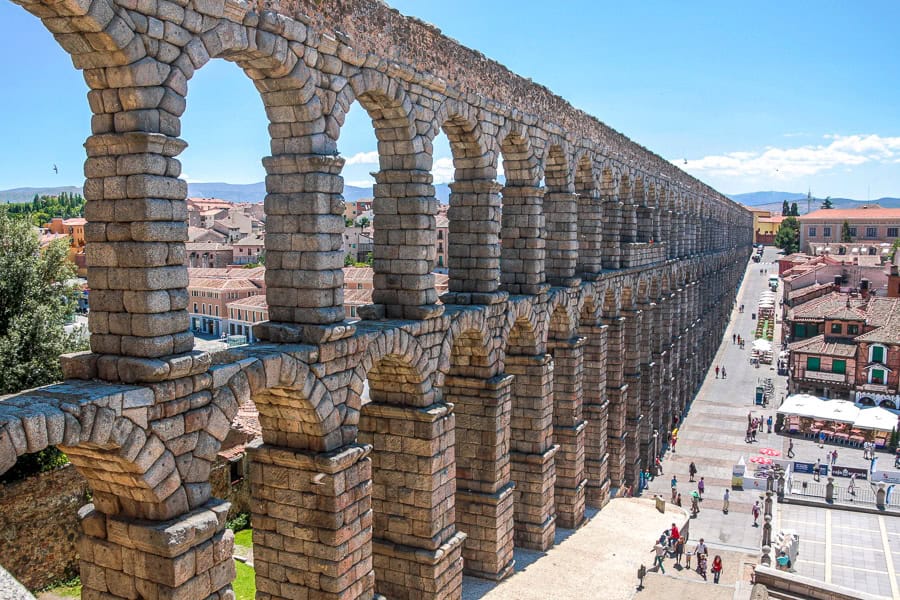
After you’ve seen the aqueduct from every angle and taken a gazillion pics (we did anyway), head up the stairs into the Old Town and take a stroll through Segovia’s wonderfully narrow cobbled laneways towards Plaza Mayor.
Here you’ll find Segovia’s pretty central square, dominated by the striking 16th century Catedral de Segovia in all its glory. It’s worth popping inside to admire the ornate chapels, choir, stained glass windows and view from the tower (subject to tour times and availability).
It’s only ten minutes’ walk from the Cathedral to Segovia’s other main drawcard, the spectacular Alcázar de Segovia. It’s without doubt one of Spain’s most impressive medieval fortresses, and said to be the inspiration for Disney’s Cinderella castle.
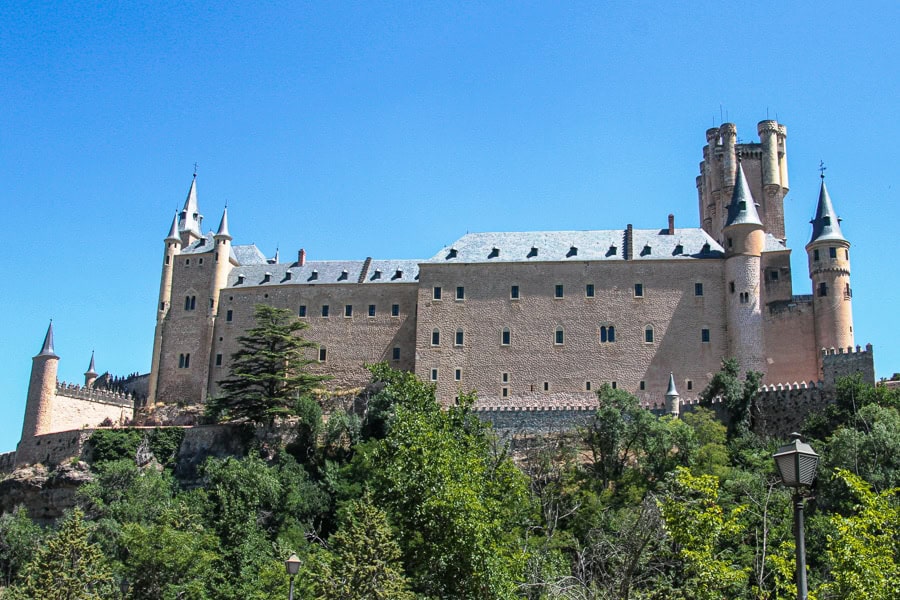
Grab some lunch in the old town (suckling pig is a local speciality) on the way back to the car before departing Segovia.
On the way out of town though, be sure to drive to one of the many Alcázar viewpoints. Mirador de la Pradera de San Marcos, and Mirador del Alcázar y los dos Valles are both particularly good.
Afternoon Visit to Ávila
It’s just under an hour to Ávila, so aim to get here mid-afternoon to allow a couple of hours to explore this medieval marvel.
Ávila is a World Heritage-listed city surrounded by an incredibly well-preserved medieval wall, topped with 2,500 turrets and 88 imposing watchtowers. It’s worth doing a circuit of the walls in the car to find a nice viewpoint or two before you head inside through one of the eight gates that guard the city.
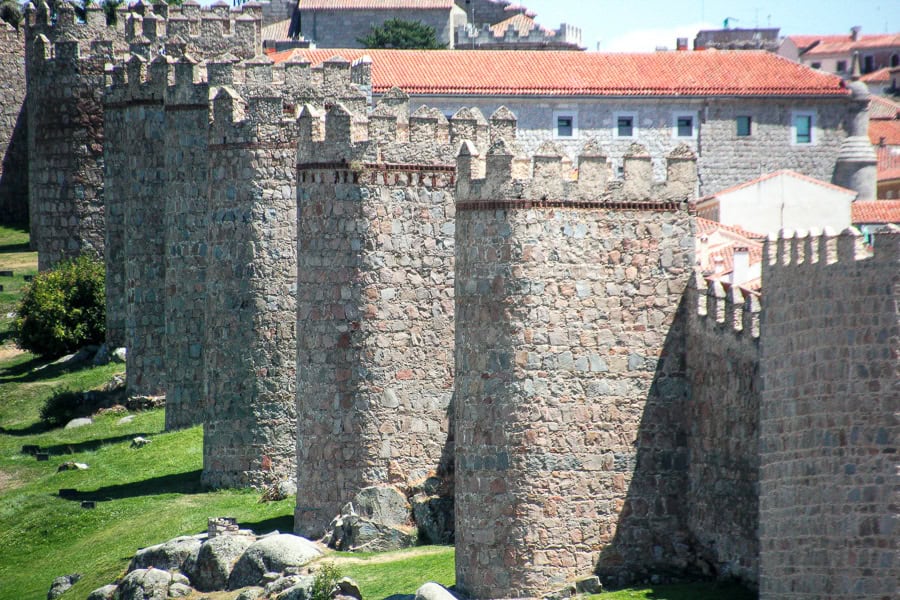
Inside the walls you’ll find a city of narrow, atmospheric streets and alleyways, beautiful plazas, and Romanesque and Gothic churches and convents, including one of Spain’s oldest Gothic cathedrals, and the church of Santa Teresa de Ávila.
While you’re here, be sure to check out some of the monumental gateways into the walled city and, if you have the time, take a walk along the city walls. There are a couple of sections that can be walked upon, for a fee.
Spend as long as you want wandering the beautiful old town, but try to be on the road in time for the final hour-long drive to Salamanca so you have time to check in and find some dinner.
If you do nothing else tonight though, make sure you head to Salamanca’s majestic Plaza Mayor to see this wonderful square beautifully illuminated at night time.
Where to Stay in Salamanca
Perhaps Castilla y León’s most beautiful city, Salamanca is a big tourist drawcard as well as being home to a healthy local and international student population. As such, it’s hardly a surprise this compact city has a decent range of accommodation to suit most budgets.
We stayed at Exe Salamanca, close to Jesuitas Park and only a short walk to the centre of town. With secure paid parking underneath the hotel, and affordable, clean, comfortable rooms, we found this to be an excellent option.
The following options also get consistently good reviews:
- Good value: Gran Hotel Corona Sol – short walk to centre | secure (paid) parking | clean, modern rooms
- Mid-range: Hospes Palacio de San Esteban – central location | beautiful renovated convent | swimming pool | super comfortable rooms | secure (paid) parking
- Indulge: Hotel Rector – luxury boutique hotel | exceptional staff | great location | secure valet parking
Day 4 – Salamanca
Highlights: Plaza Mayor | Catedral Vieja | Catedral Nueva | Universidad Civil | Puente Romano | Convento de San Esteban
Total driving distance: No driving today as you explore Salamanca.
Overnight: Salamanca
With a history stretching back almost three millennia, spanning Carthagean, Roman, Moorish and Christian eras, as well as one of Spain’s oldest universities, and a rich cultural and architectural heritage, it’s little wonder Salamanca is a World Heritage-listed city.
If you like history and architecture then you’ll be like a kid in a candy store as you walk the old city’s pedestrianised streets, enjoying numerous elegant plazas, and marvelling at the richly ornate golden sandstone facades that seem to be around every corner.
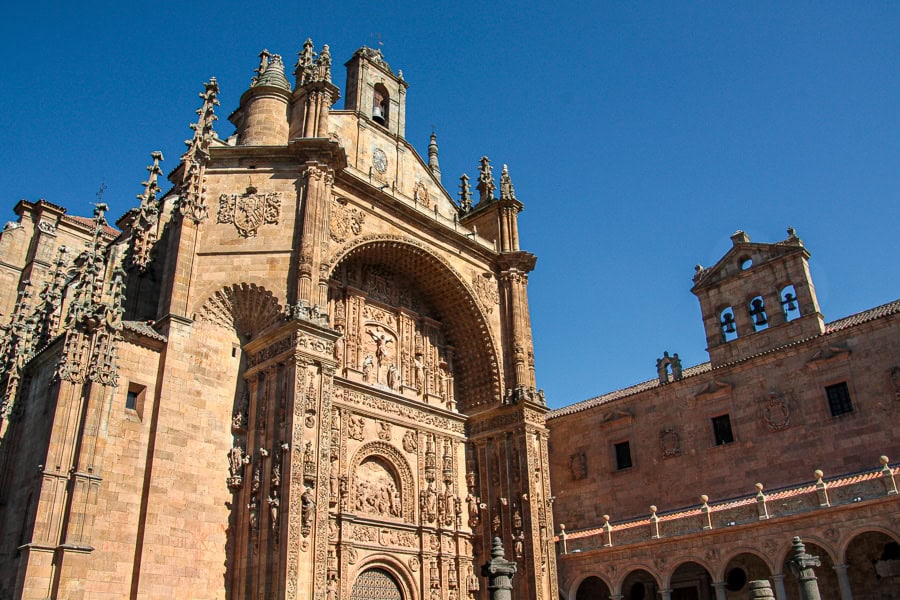
In a city bursting at the seams with beautiful buildings and monuments, standouts include Salamanca’s impressive Roman Bridge – the Puente Romano, iconic Casa de las Conchas with 300 carved scallop shells clinging to its hulking exterior, the stunningly ornate Convento de San Esteban, and striking Casa Lis, housing the city’s museum of decorative arts.
And then there’s Salamanca’s two cathedrals. You read that right, there are two cathedrals here, and they are both stunners.
Romanesque Catedral Vieja is the older of the two, dating back to the 12th century and renowned for its exceptional 53 panel altarpiece.
The new cathedral, Catedral Nueva, was inaugurated in 1733 and has a beautiful, ornate façade with particularly striking doorways. The interior is also breathtaking, with lovely sculptured choirs and richly decorated chapels. While inside, remember to look up to enjoy the ceiling, especially the beautifully decorated octagonal dome.
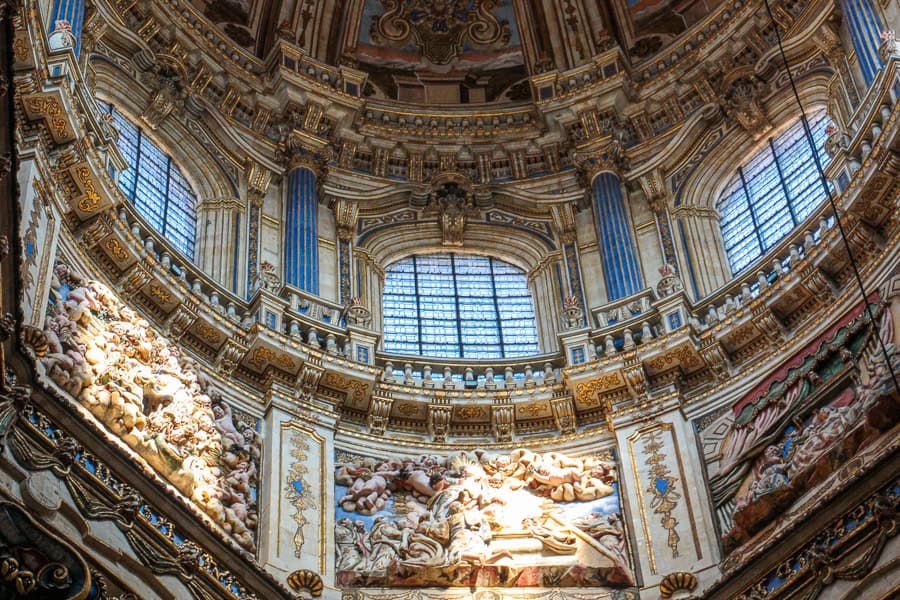
Perhaps the most historically important part of the old city, however, is the cluster of beautiful sandstone buildings that make up the Universidad Civil. Dating back to the 1200s, it’s an area that is worth dwelling in to really appreciate one of the oldest continually operated universities in the world.
And then of course there’s Plaza Mayor, probably our favourite spot in the whole city and somewhere we were constantly drawn back to. For us, this beautiful space with its wonderful buzz is one of Europe’s most beautiful squares.
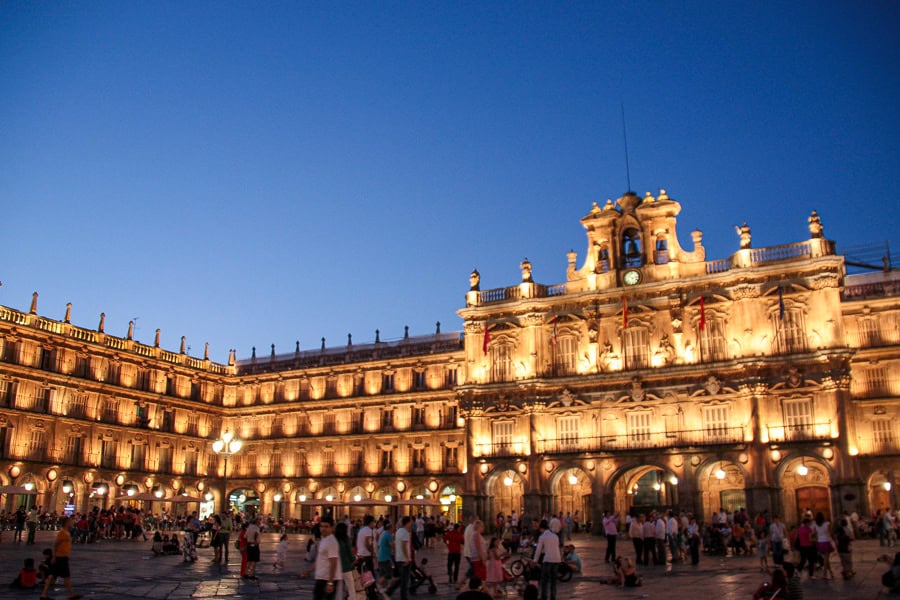
If this all sounds like quite a lot to pack in you’ll be relieved to hear that Salamanca is a refreshingly walkable city. It’s a little over a kilometre between the Puente Romano in the south to Plaza Mayor, and you can easily explore the city independently.
However, if you want a guided experience, there’s a fun tourist train from Plaza de Anaya that takes you around most of the main sights. Or you could consider a self-guided audio tour, guided walking tour, or guided tour by bike, all of which get great reviews from other visitors.
Day 5 – Salamanca to Seville via Mérida
Highlights: Acueducto de los Milagros | Puente Romano de Mérida | Teatro Romano | Circo Romano
Total driving distance: appx. 460 km (280 miles)
Total driving time: appx. 4.5 hours
Overnight: Seville
You’ll be covering nearly 500 kilometres today as you move into our southern Spain itinerary. So we’d recommend hitting the road early enough to get to Mérida by 10am. It’s around two and a half hours’ drive from Salamanca.
As fans of all things Roman, we could easily spend a few days in the city of Mérida. It was founded by Augustus in 25BC after the conquest of northern Hispania. But even if your interest in Ancient Rome is less enthusiastic, it’s hard not to be impressed by the well preserved remnants of Augusta Emerita, another World Heritage site.
On the way into Mérida, stop by Parque del Río Albarregas so you can wander down to see the hulking remains of the 2,000-year-old Acueducto de los Milagros and nearby Puente Romano del Río Albarregas, which once marked the northern entry to the Roman city.
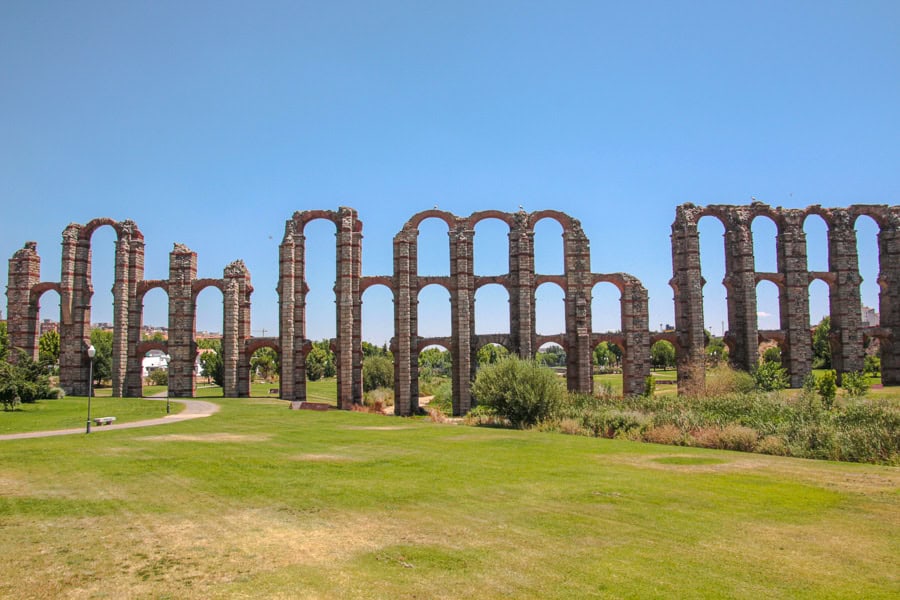
Fortunately, Mérida is another city that packs a big historical punch into a relatively compact space. It’s a very walkable city so we’ve outlined our suggested walking route below if you want to see everything under your own steam. You’ll need three to four hours to really appreciate the main sites here.
Alternatively you could opt for the very well regarded Complete Roman Tour in Merida, which covers many of the main sites with a knowledgeable guide (entry fees are additional) on a 3 hour tour.
Self-Guided Walking Tour of Mérida
If you’re visiting independently, head to the centre of town and grab a coffee overlooking the Temple of Diana, which provides a very real sense of how a modern city has somehow managed to grow around an Ancient Roman settlement.
From here you are literally surrounded by Roman history. The 15-metre-high Arco de Trajano is just a few hundred metres to your west, while a short walk south towards the Río Guadiana brings you to the Puente Romano de Mérida, a wonderfully restored 25BC Roman bridge.
Break up your journey through Roman history by walking back towards the city and popping into the 9th century Alcazaba Islamic fort with its impressive cistern and views of the Roman bridge. Then head east to see how wealthy Romans once lived (and died) with a stop to admire the beautiful mosaics and frescoes of Casa del Mitreo, and the crypts of the nearby Los Columbarios funerary site.
Find somewhere for a quick lunch before wrapping up Mérida with what is, for us, the two most iconic sites in the city, the Teatro Romano, and nearby Anfiteatro.
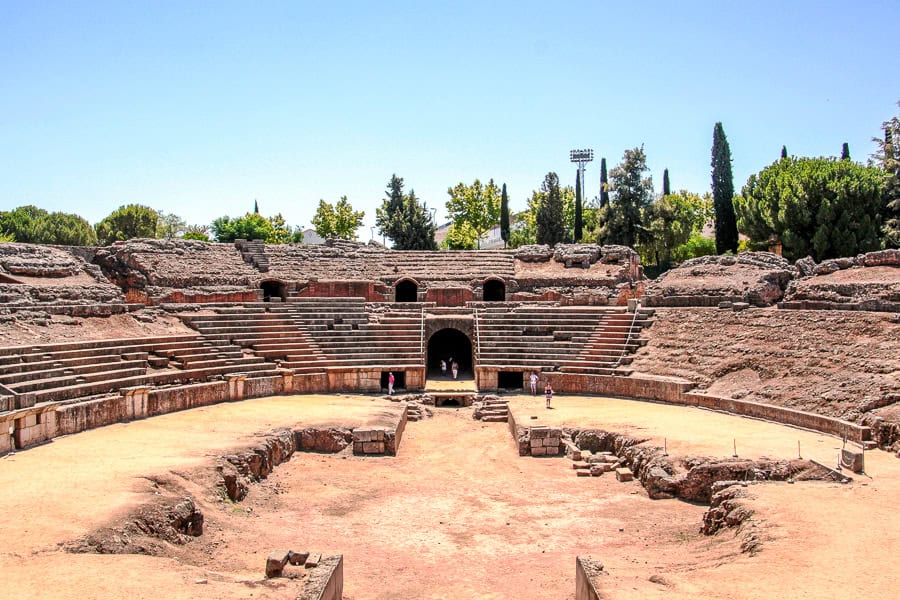
There’s something quite surreal standing in Mérida’s Anfiteatro as you imagine 14,000 people screaming for their favourite gladiator. Even more impressive is the Teatro Romano right next door, forming what once must have been a monumental Roman entertainment precinct.
Undoubtedly the highlight of our visit to Mérida, the theatre would have once hosted 6,000 spectators and is still remarkably well preserved, with its stage, Corinthian columns, and some statues still relatively intact. The site still hosts performances but you’ll need to plan ahead if you’d like to have a truly unique theatre experience.
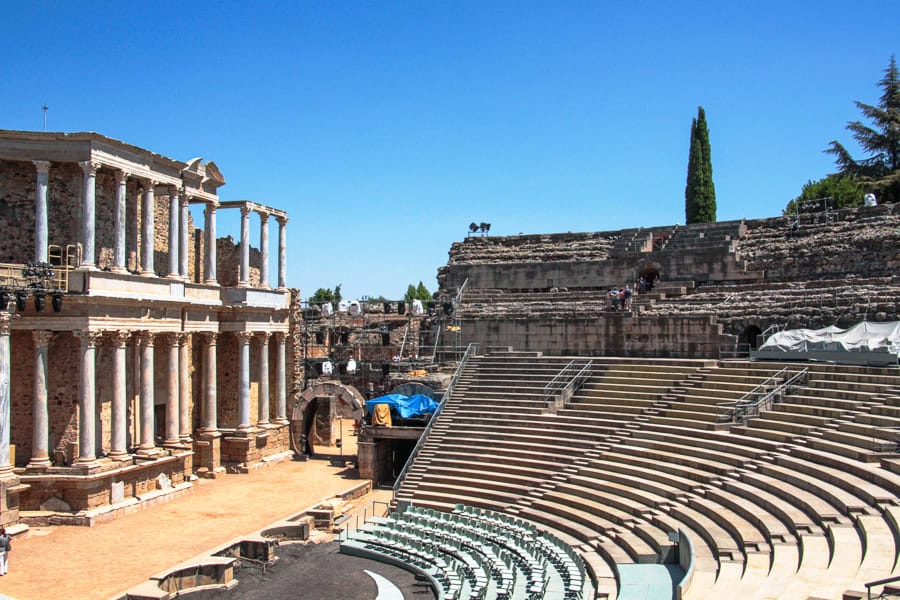
Die hard Roman fans like us may still find the energy for a quick visit to the Acueducto de San Lázaro and nearby roman baths, along with Spain’s only surviving hippodrome, the Circo Romano de Mérida. These are all located in the northeast sector of the city if you have the time (and energy) to see them before making the final, two hour drive to Seville (ideally, start your day even earlier if you want to include this).
Eating in Seville is a late affair, so you’ll probably have time for a brief rest before heading out for a taste of Seville’s famed tapas (energy levels permitting). Barrio Santa Cruz or Arenal are both good bets if you’re looking for a tapas fix or something more substantial.
Where to Stay in Seville
As Andalucía’s capital city, Seville has plenty of options when it comes to choosing somewhere to stay. Whether you want a self-contained apartment, boutique hotel, or a luxury stay in a renovated mansion, you’ll have plenty of choice here. Our only gripe is the lack of free hotel parking, although this is getting more common these days.
We stayed at Hotel Monte Carmelo, a smart, comfy hotel just 15 minutes stroll across the river from the old town. The hotel has secure on-site parking (paid), staff were super friendly, and the rooms are clean and modern.
The following options get consistently good reviews:
- Good value: Hotel AV la Florida – central location | spacious clean rooms | secure paid parking nearby
- Mid-range: Hotel Rey Alfonso X – secure (paid) valet parking | clean, spacious rooms | rooftop bar and pool | central location
- Indulge: Radisson Collection Hotel, Magdalena Plaza Sevilla – central location | comfy modern rooms | great breakfast | rooftop bar and pool | paid parking nearby
Day 6 – Seville
Highlights: Seville walking tour | Catedral de Sevilla | Royal Alcázar of Seville | Flameno Show
Total driving distance: No driving today as you explore Seville.
Overnight: Seville
As you start to road trip southern Spain, you’ll notice the temps rising and Moorish influences blending with traditional Spanish styles.
Today is a busy one so we recommend grabbing a hearty breakfast (coffee and tostada is a good option here), before heading into town for a walking tour.
With consistently good reviews, friendly, knowledgeable guides, and free cancellation, this 2 hour, small group city highlights walking tour is a great way to get an introduction to the history and culture of Seville.
The tour takes you past (but not inside) some of Seville’s most iconic landmarks, like the Catedral de Sevilla, Torre del Oro, the Royal Alcázar, Universidad de Sevilla, and Parque de María Luisa, before finishing up at the park’s flamboyant centrepiece, Plaza de España.
We have you exploring inside a few of those places in the afternoon, but before you grab lunch, take a turn around Plaza de España to really appreciate its extravagant style, complete with boating canal, fountains, and ornate bridges. Be sure to check out the beautifully tiled alcoves around the square, each representing a different province of Spain.
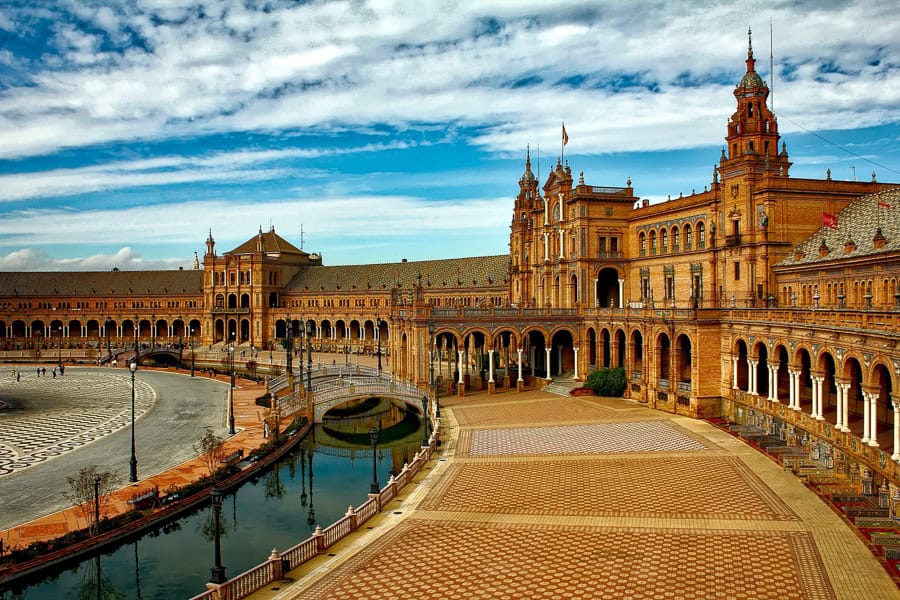
Leave Plaza de España and take a walk through the maze of streets, laneways and plazas that make up Barrio de Santa Cruz, Seville’s medieval Jewish quarter. It’s a lively area with plenty of bars and restaurants so grab lunch anywhere that takes your fancy.
After lunch (and perhaps a little siesta if you feel like it), it’s time to explore two of the absolute highlights of Seville: the World Heritage complex comprising the wonderfully ornate Catedral de Sevilla, and the exquisite Mudejar-style Royal Alcázar of Seville.
Catedral de Sevilla
You’ll be straining your neck exploring the cavernous, ornately decorated interior of Catedral de Seville, one of the world’s largest Gothic cathedrals. Completed in 1507, the cathedral is famous for its huge, elaborate main altar, intricate stained glass windows, richly adorned Sacristy of Chalices, and the lavishly decorated tomb of Christopher Columbus, among other treasures.
We really enjoyed our climb up the 100-metre high Giralda, the cathedral’s beautiful minaret and we recommend buying the extra ticket to do this. It’s a hugely popular attraction, so consider booking a timed Cathedral and La Giralda Entry Ticket (with or without audio guide) in advance of your visit.
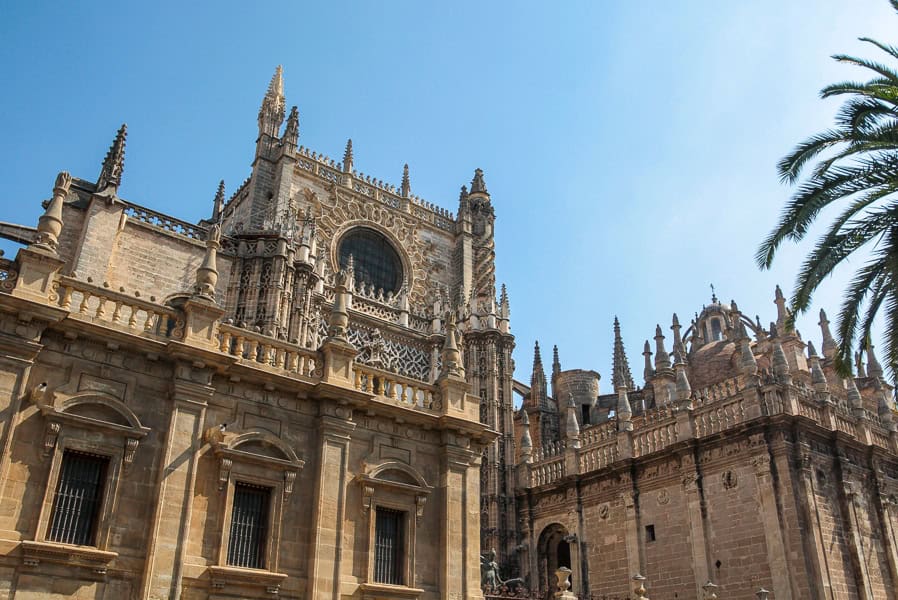
Royal Alcázar of Seville
A proud testament to Seville’s Moorish past, the Royal Alcázar has watched over Seville for more than a millennia, first as a fortress, and later as a lavish royal palace.
We fell in love with the Alcázar’s exquisite Mudejar style and architecture as we ambled through the richly decorated royal chambers, stunning patios and extensive gardens, while marvelling at the intricate plasterwork, beautiful ceramic tiles and stunning archways.
There are far too many highlights to mention, but memories of the wonderful, fountain-filled gardens, the breathtaking Patio de las Doncellas, and ornately decorated Hall of Ambassadors with its mesmerising dome will stay with us for a long time.
You’re not going crazy if this place feels a little familiar. Numerous spots here were used to depict the Water Garden of Dorne in Game of Thrones.
As with the Cathedral, there are often long queues to enter, so booking a timed entry ticket from the Official Website, or through GetYourGuide in advance of your visit will save you some time. It’s also worth noting that you may need to show your passport to gain entry.
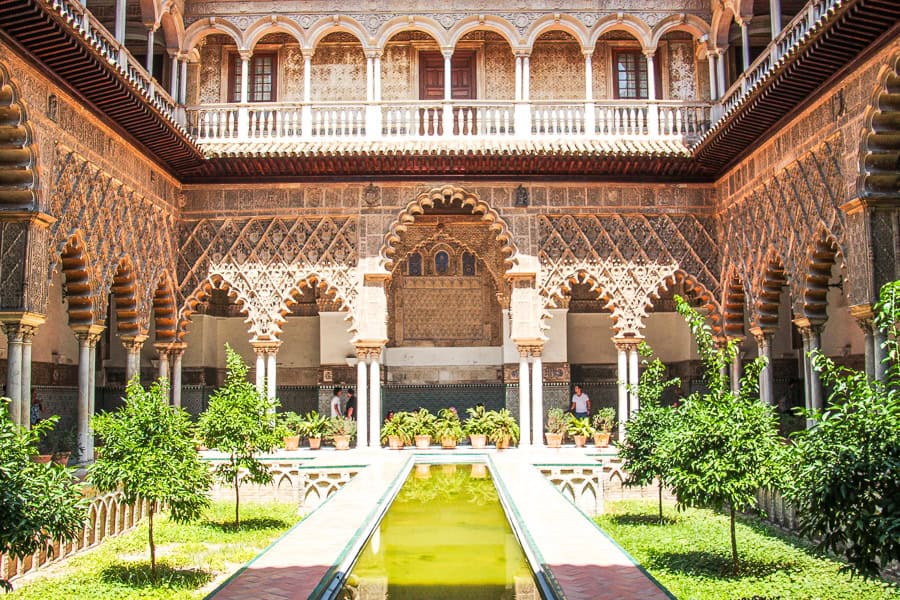
If you want a more immersive experience of these iconic sites with a tour guide, as well as benefits like ‘skip the queue’ tickets, then it’s well worth considering the Priority Access Cathedral, Giralda & Alcázar Tour. This will require reorganising your day a little since the tour starts at 12:30, but the reviews are consistently good.
It’s been a huge day, so we’ll forgive you if you’re ready to fall into an exhausted heap and crawl into bed after grabbing the first thing you can find to eat. However, if you still have some energy, why not head out into the hustle and bustle of Seville to experience two of the things this city is famous for: tapas and flamenco.
There are plenty of options for both around the city, but if you want someone else to do all the hard work, and explain things along the way, then a guided, small group Tapas and Flamenco Experience in the vibrant Triana neighbourhood might be just the ticket (this one gets great reviews).
Day 7 – Seville to Ronda via the Pueblos Blancos (White Towns)
Highlights: Arcos de la Frontera | Grazalema | Zahara de la Sierra | Setenil de las Bodegas | Ronda Sunset
Total driving distance: appx. 215 km (135 miles) if you visit all of the white towns listed below.
Total driving time: appx. 3.5 hours if you visit all of the white towns listed below.
Overnight: Ronda
Day seven of our Spain road trip will take you southeast of Seville to explore the magnificent pueblos blancos (the white towns) of Andalucia. It’s a journey through some of southern Spain’s most picturesque landscapes to see these iconic whitewashed clifftop villages.
Today’s itinerary is bit of a ‘choose your own adventure’ as you can pick the white towns that most appeal to you on the way to our final stop – Andalucia’s most famous white town – Ronda. Or do them all – see more below.
Arcos de la Frontera: Perched dramatically atop a limestone cliff, Arcos de la Frontera is your quintessential white town overlooked by an 11th century Moorish castle. As you wander through its narrow streets, you’ll be greeted by whitewashed houses, beautiful churches, lovely plazas and panoramic views over the Guadalete River.
If you want a nice viewpoint of the town, Mirador del Cerro is a good option. For the classic Arco photograph (and if have a longer lens), check out Mirador Los Cabezuelos for views from the south with Puente De San Miguel in the foreground.
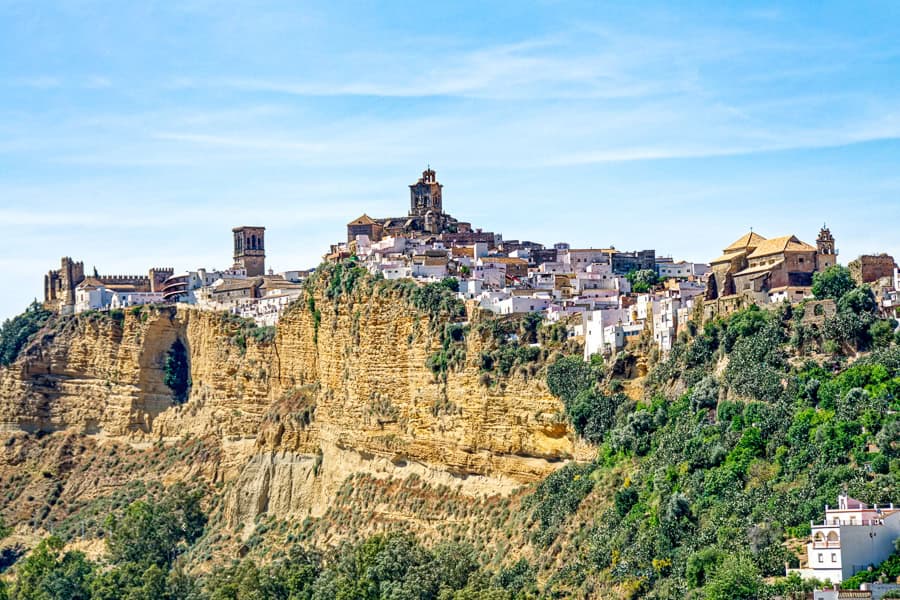
Grazalema: Located within the Sierra de Grazalema Natural Park, Grazalema enjoys a slightly cooler mountain climate, making it a popular base for outdoor activities ranging from hiking and climbing to canyoning and kayaking. It’s a lovely place to stretch your legs, grab some traditional tapas, or seek out the local cheese and honey the town is known for.
Zahara de la Sierra: If you were going to design the picture-perfect white town, you could do far worse than setting it on rocky promenade beside a beautiful turquoise reservoir, overlooked by a 12th-century castle.
This is another charming town of narrow, cobblestone lanes, beautiful churches and lovely views. If you have the energy, the short but steep climb up to the castle is well worth the effort for the panoramas of the surrounding countryside. If you happen to be here around lunch time, you’ll also find a decent selection of cafes and restaurants, some of which have terraces overlooking the iridescent reservoir.
Setenil de las Bodegas: Head to Setenil de las Bodegas for a white town with a unique point of difference. The town has been built into a canyon straddling the Rio Trejo, with unique cave houses built directly into the rock.
There’s a 12th century castle here, and plenty of viewpoints like Mirador del Carmen. The highlights though, are the cave houses, so make sure you meander along the most famous streets, including Calles Herrería, Cuevas del Sol and Cuevas de la Sombra. As many of these houses are now bars and restaurants, it’d be rude to leave without at least stopping for a cold drink.
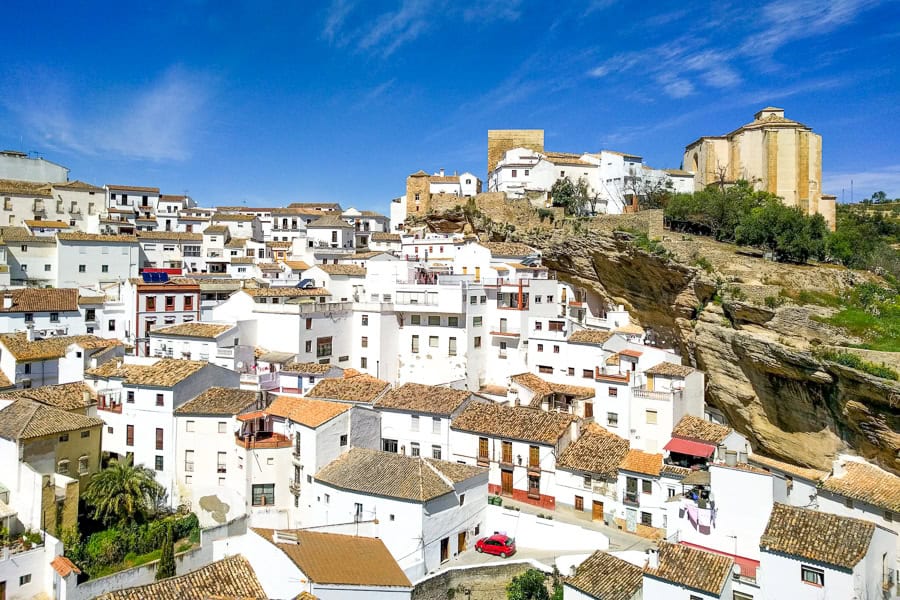
Ronda: Pretty much the perfect end to a day of exploring the Ruta de los Pueblos Blancos. Ronda is the most famous white town of them all, and you’ll be spending tomorrow walking its cobbled streets and discovering its Moorish heritage, ancient bull ring, and spectacular viewpoints.
For now though, check into your hotel, and then head to Mirador de Ronda, or Promenade Kazunori Yamauchi for sunset. Or book a table with a view at one of the restaurants along Calle Tenorio, such as Arrabal Restaurante or Restaurante Albacara.
Ruta de los Pueblos Blancos the easy way
While it’s absolutely possible to see all of the white towns above in a single day, we’ll be honest and say it would be a pretty huge day that would feel quite rushed.As such, it might be better to see fewer towns at a more leisurely pace with a nice lunch stop thrown in for good measure.
You could also consider staying an extra night in Seville and taking a white villages tour. The Pueblos Blancos and Ronda Full-Day Trip gets decent reviews, and while you may not see as many white towns (the tour only visits Zahara de la Sierra, Grazalema and Ronda), it does mean you won’t have to worry about driving or parking. You can also enjoy a bevvie along the way if you fancy it.
Where to Stay in Ronda
Despite being fairly small, Ronda has a surprisingly good range of decent accommodation at various price points, many of which include parking, although often for a fee. The following options all come highly recommended:
- Good value: Apartamentos Turísticos Espinel – clean, spacious apartment | central location | friendly host | free parking
- Mid-range: Ronda City Wall Apartments – tastefully furnished apartment | short walk to centre | free parking nearby | private plunge pool
- Indulge: Catalonia Ronda – rooftop terrace with pool | views of the bullring | clean comfy rooms | close to everything | valet parking (paid)
- Indulge: Catalonia Reina Victoria – spectacular gorge views | comfy, tasteful rooms | pool and spa | on site (paid) parking | short walk to centre
Day 8 – Ronda (and a Wine Tour)
Highlights: Plaza de Toros | Puente Nuevo | El Tajo Gorge | Wine Tour and Tasting | Casa del Rey Moro | Iglesia de Santa María La Mayor
Total driving distance: No driving today unless you opt for a quick winery visit near to Ronda.
Overnight: Ronda
Start nice and early today with a quick stroll through Alameda del Tajo to enjoy fabulous views of the mountains around Ronda before heading to Plaza de España for a coffee fix.
You’ve probably seen photos of Ronda’s iconic Puente Nuevo bridge. It dramatically straddles El Tajo Gorge, connecting the old Moorish town with the more modern city. Seeing it up close is something special.
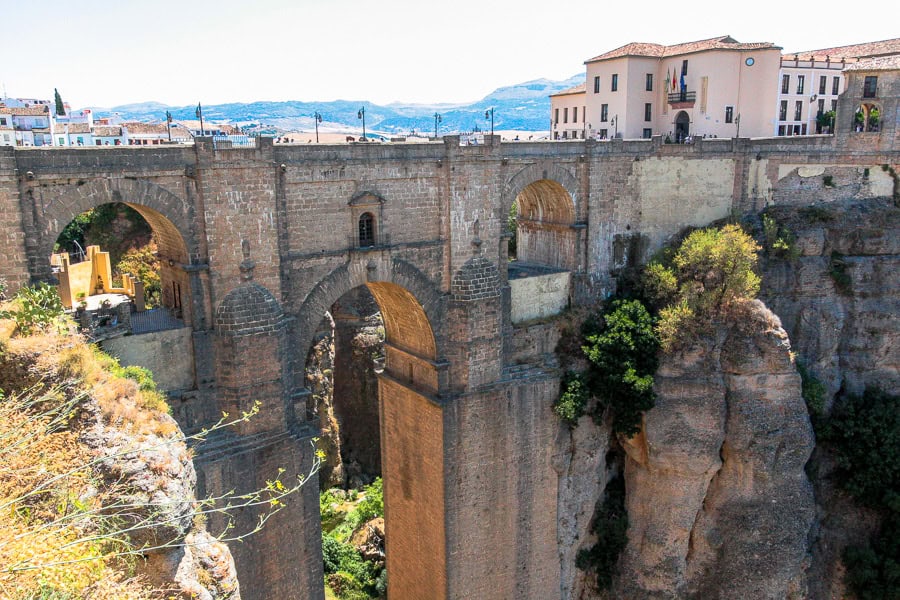
Enjoy the views of the city and gorge from both sides of the bridge, and then hike down to the Puente Nuevo Viewpoint or, if you are feeling energetic, all the way down to Mirador La Hoya Del Tajo (you can also drive to this one if you prefer). It’s good to go nice and early when it’s less hot and crowded.
Make sure you’re back at your hotel in time for the 20 minute drive (or taxi) to Bodega Doña Felisa to get a taste for some local wine and tapas. The guided tour with tasting here starts at 11:30am and tours the winery before a tasting of three wines with paired tapas. Tours can be booked in advance and get great reviews by other travellers.
Back in Ronda, pay a quick visit to Plaza de Toros and the Museo Taurino to learn a little about Spain’s bullfighting tradition. Then head back across the new bridge into the old town to wander its cobbled streets and get a sense of Ronda’s Arabic roots. Take note of the extensive walls as you walk around town, check out the fabulous views at Puente Viejo, Casa del Rey Moro and Iglesia de Santa María La Mayor, and make time to visit the atmospheric Arab baths.
As evening draws closer, repeat yesterday’s plan and find a sunset view followed by a nice perch for dinner.
Day 9 – Ronda to Granada via the Dolmens of Antequera
Highlights: Dolmen de Menga and Dolmen de Viera | Catedral de Granada | Mirador San Nicolas | Alhambra night visit
Total driving distance: appx. 180 km (110 miles)
Total driving time: appx. 2.5 hours
Overnight: Granada
It’s another early start today as you’ll want to be arriving at the dolmens of Antequera for opening at 9am. This ancient place is a little over an hour’s drive from Ronda, and yet another incredible site with World Heritage status.
History nerds that we are, we absolutely loved this site. These are some of Europe’s best megalithic monuments, and they’ve graced this landscape for more than 4,500 years. Best of all, there’s plenty of car parking, and it’s free to enter.
We recommend focussing your visit on Dolmen de Menga and Dolmen de Viera as they are close together and near the Visitor Centre. Menga in particular, with its long internal chamber and large stone slabs weighing up to 180 tonnes is something of an engineering marvel.
Be sure to take in the surrounding landscape at Dolmen de Menga and see if you can spot Peña de los Enamorades, an unusual mountain that looks distinctly like a human face.
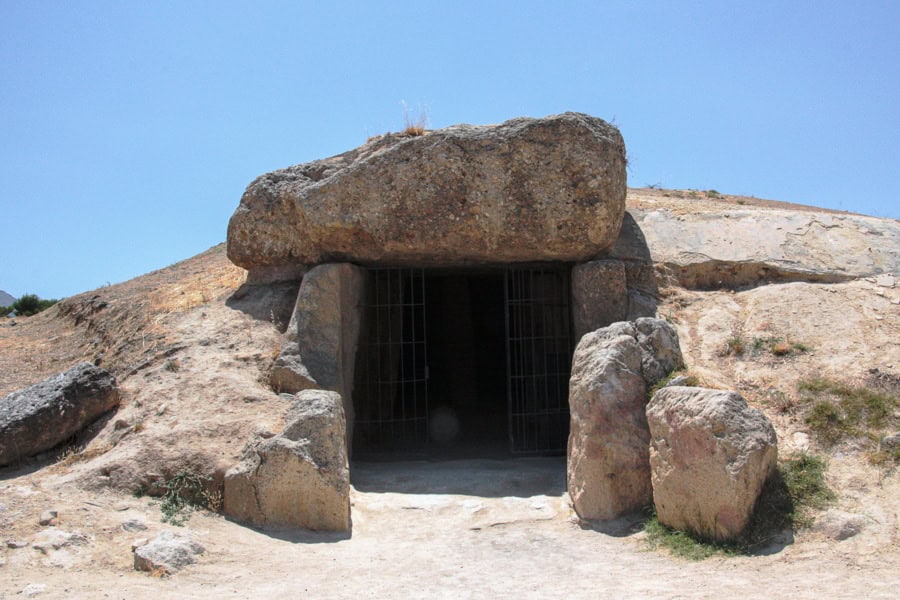
Visiting Granada
It’s around 100km, or a little over an hour to drive from the dolmens to Granada. Try to organise an early check in or bag drop at your hotel so you can park the car and get out on foot to explore this incredible city in the Sierra Nevada foothills.
Start your exploration of the city with a visit to the Catedral de Granada. With its Baroque façade, soaring domed ceiling, intricate altarpieces and impressive stained glass windows, this former mosque is a great place to start your tour of Granada.
You’ll need a separate ticket to get into Capilla Real next door, the elaborate Gothic resting place of Spain’s famed Royals, Isabella and Ferdinand.
If you haven’t already succumbed to hunger, then pop into nearby Mercado de San Agustín for a bite and some refreshment before strolling 10 minutes to Monasterio de San Jerónimo.
This 16th century building with its elaborate façade, beautiful Gothic cloisters and richly decorated church is well worth a quick visit before you continue onwards to Basílica San Juan de Dios, another truly opulent basilica famed for its gold altarpiece.
Spend the rest of the afternoon in Granada’s World Heritage Albaicín neighbourhood, recognised for its unique blend of Andalucian and Moorish medieval architecture. It’s a lovely place to wander, with narrow, sometimes steep cobblestone lanes and squares, and plenty of fantastic viewpoints.
As the sun drops, plan to be at Mirador San Nicolas for one of Granada’s legendary sunsets. Or better still, find a nice restaurant or bar with the same view and enjoy drinks and a bite to eat before heading down the hill to experience yet one more highlight, a night visit to the Alhambra.
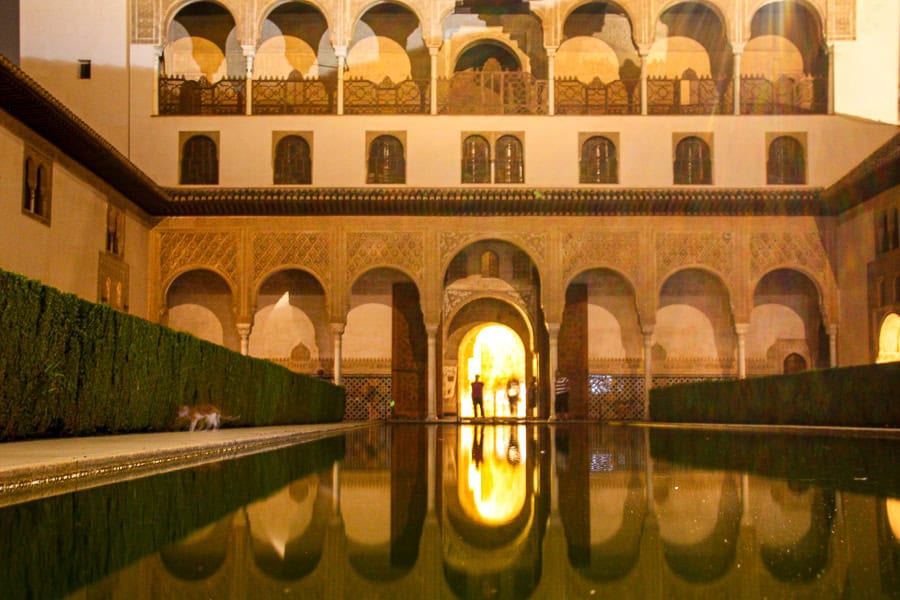
Night Visit to the Alhambra
Granada’s premier World Heritage attraction needs no introduction but we discuss it more in tomorrow’s itinerary.
You’ll need to pre-book an Alhambra Night Visit Entry Ticket in advance, making sure you select the Nasrid Palaces and Charles V Palace option unless you’d prefer to see the gardens and Generalife.
Aim to get to the entry well before opening at 10pm to make the best of the relatively short 90 minutes allowed for a night visit. Don’t be put off by the short duration, visiting the Alhambra at night is a truly magical experience, with ambient lighting, cooler temps and less people – we can’t recommend it highly enough.
Where to Stay in Granada
Whether you choose the Moorish delights of Albaicín, the convenience of the historic centre, the lively Realejo, the Alhambra, or budget conscious Beiro, there’s really no shortage of accommodation in Granada. Choose from budget hostels and guesthouses to roomy apartments, tasteful boutique hotels and renovated old mansions.
The following options get consistently good reviews:
- Good value: Smart Suites Albaicin – great location | helpful staff | clean and modern | secure (paid) parking
- Mid-Range: Domus Apartamentos Granada – clean spacious apartment | short walk to cathedral | free parking nearby
- Indulge: Palacio Gran Vía – central location | rooftop bar with views | tasteful, modern rooms | spa and pool
We stayed at Hotel Macià Real de La Alhambra, located 3 kilometres from Granada but with decent bus connections. Rooms are clean and comfortable and there’s paid parking on site, as well as a swimming pool, terrace, Arab baths and restaurant.
Day 10 – Visiting the Alhambra and Exploring Granada
Highlights: Alhambra | El Bañuelo | Sacramonte neighbourhood | Mirador de San Miguel Alto
Total driving distance: No driving today as you explore Granada.
Overnight: Granada
Today is all about the majestic Alhambra, one of the most beautiful Islamic palaces in the world, and the main reason for our visit to Granada.
If you visited last night, then you’ve already enjoyed an ambient nocturnal flirtation with this Spanish icon. Today, you’ll be getting to know her much, much better.
Visiting the Alhambra
You’ll need at least half a day to fully appreciate this sprawling palace-fortress complex, set on a hilltop overlooking Granada. The site consists of four main areas: the Nasrid Palaces, the Alcazaba, the Generalife, and the Palace of Charles V.
The Nasrid Palaces are the crown jewel of the Alhambra, featuring a mesmerising series of exquisite courtyards, halls, patios and intricately designed rooms. Highlights include the Patio de los Leones, with its famous marble fountain, the Sala de Dos Hermanas, with its impossibly ornate octagonal ceiling, the Salón de los Embajadores, a grand room with ornate stucco work, and the peaceful Patio de los Arrayanes, with its well photographed rectangular pool.
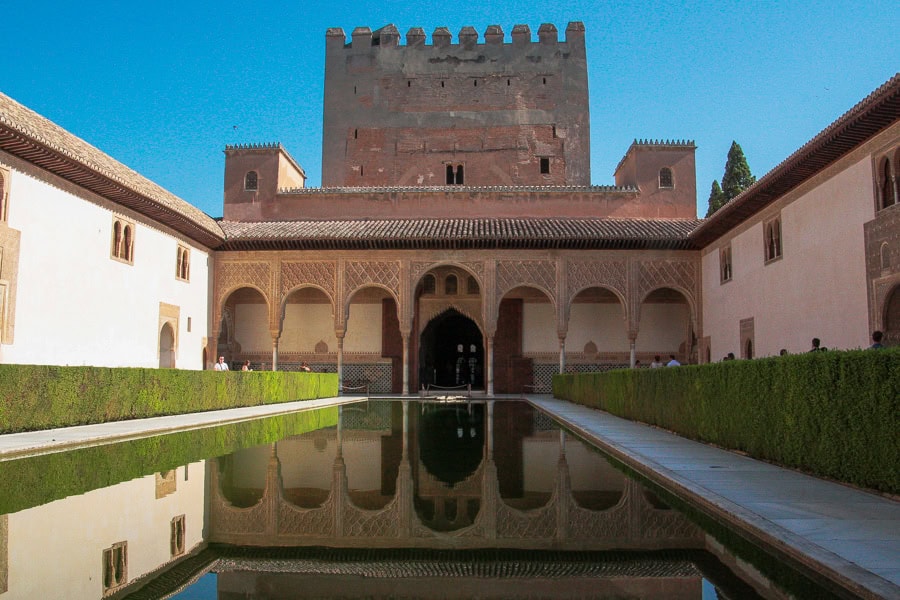
The Alcazaba is the oldest part of the Alhambra, serving as a fortress from as early as the 11th century. Its watchtowers offer panoramic views of Granada and the Sierra Nevada mountains, making it a perfect spot to take a well-earned rest and enjoy the views.
The Generalife, the sultan’s fabulous summer palace and garden, would have been a peaceful retreat with its lush gardens, fountains, patios, pools and pathways. Highlights are the Palacio del Generalife itself, as well as the Patio de la Acequia, with its graceful long pool flanked by colourful flowers and views of the Nasrid Palaces.
Finally, the imposing Palace of Charles V now houses two museums, the Museo de la Alhambra and the Museo de Bellas Artes. The Renaissance palace is perhaps best known for its striking two-tiered circular colonnaded courtyard.
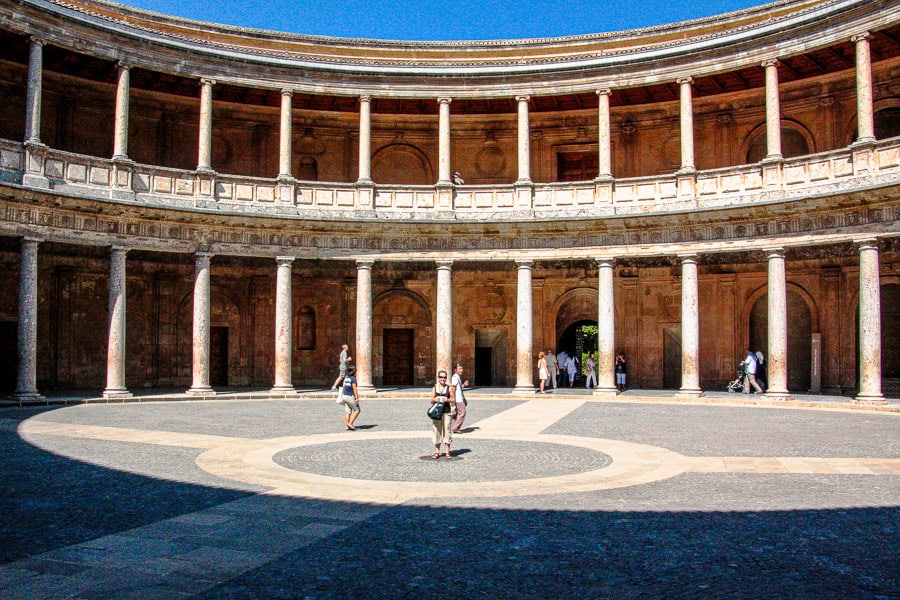
Practical Tips for Visiting the Alhambra
Granada’s top tourist attraction is also one of Spain’s most visited sites. So buying tickets in advance is a must.
You can get tickets through the official website, and also through some third party sites like GetYourGuide, which has an Alhambra and Nasrid Palaces Entry Ticket that can sometimes still be available, even when the official site has sold out.
The timed entry you select when purchasing tickets is for entry to the Nasrid Palaces. All other areas of the complex can be visited at your leisure.
It’s also worth noting that you will need to show your ticket and passport to gain entry at various points during your visit. Bags larger than 40×40 cm, along with camera tripods, are not allowed (free lockers are provided at the access pavilion and Puerta del Vino).
If you want to have a guided experience for your visit, which we would highly recommend, you can opt for a small group tour which includes entry ticket, or an entry ticket with audio guide. Both options get good reviews.

Afternoon and Evening in Granada
You’ll definitely be ready for some lunch and probably a little siesta after a few hours tackling the Alhambra, so indulge in one or both and recharge your batteries before heading back out into the city for one final wander this afternoon.
Have a stroll down Carrera Del Darro, a lovely cobblestone pathway along the Darro River with nice views of the Alhambra along the way. Then pop in to see Baños Árabes El Bañuelo, one of the best-preserved Moorish bathhouses in Spain, notable for its beautiful brick arches and star-shaped skylights.
Spend the rest of the afternoon and evening wandering the Sacramonte neighbourhood, known for its white cave houses and traditional culture. As you wander its steep, winding streets, you’ll spy plenty of wonderful viewpoints. Pick one for sunset, Mirador de San Miguel Alto for example, and then grab a bite at one of the area’s many lively restaurants before enjoying one of its famous flamenco shows.
Day 11 – Granada to Córdoba
Highlights: Mezquita-Catedral de Córdoba | Córdoba Bell Tower | Patio de los Naranjos | Calleja de las Flores | Palacio de Viana
Total driving distance: appx. 161 km (100 miles)
Total driving time: appx. 2 hours 15 mins
Overnight: Cordoba
A couple of hours north of Granada lies the equally impressive, historically important city of Córdoba. With its Roman origins and fabulous blend of Islamic and Christian architecture, Córdoba is a bustling city of narrow streets with a vibrant Jewish Quarter, and beautiful flower-filled patios.
If you arrive in Córdoba by mid-morning, you should still have plenty of time to drop your bags off and visit the city’s most famous attraction, the Mezquita-Catedral de Córdoba.
This vast, sublime mosque, founded in the 8th century and with a 16th century cathedral planted right in its heart, was the main reason for our visit to Córdoba and it absolutely lived up to expectations.
The Mezquita is one of Spain’s architectural treasures. It’s a building that brings Islamic and Christian designs together in a mesmerising blend of sculpted archways, soaring domes and intricate mosaics. The intricate mihrab and maksura are particularly striking, but it was the mesmerising red and white arches of the prayer hall that we were drawn to the most.
While you’re here, be sure to climb the Córdoba Bell Tower (a separate ticket) to enjoy panoramic views of the city. Then pause to enjoy the ambience of the Patio de los Naranjos with its fragrant orange trees.
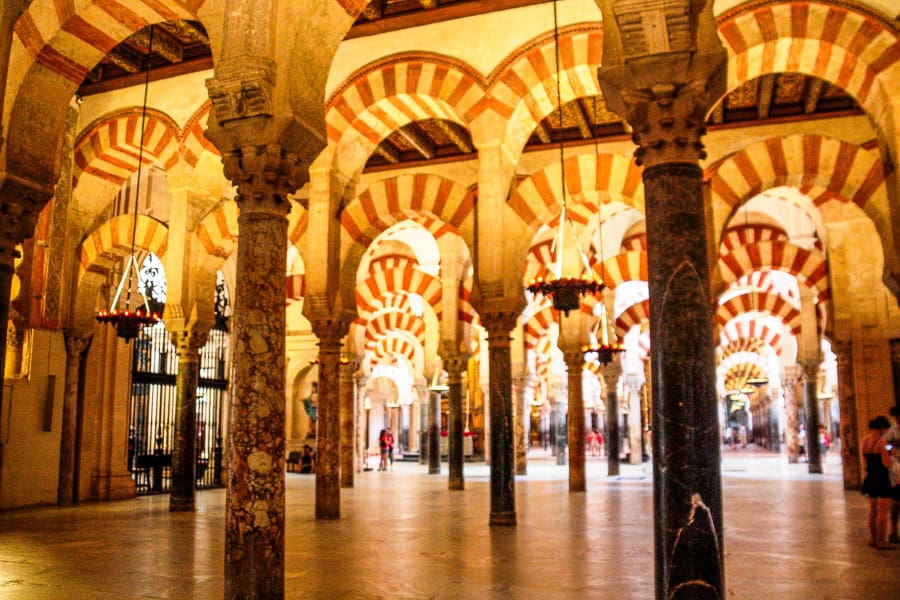
As you leave the area, check out one of Córdoba’s most picturesque streets, Calleja de las Flores, with its flower-filled balconies and bell tower views.
Grab some lunch at one of the many tabernas near Plaza del Potro or at one of the cafes around monumentally proportioned Plaza de la Corredera.
After lunch, pass by Templo Romano on the way to Palacio de Viana, a stunning palace with a lovely garden and 12 beautifully preserved patios. There are guided tours of the rooms here if you are interested.
It wouldn’t be Andalucia road trip if you didn’t end your day at a traditional tapas bar, sampling local specialities like berenjenas fritas (fried eggplant), rabo de toro (oxtail stew), or Salmorejo (a cold tomato soup). It’s a city also famous for – you guessed it – flamenco. So if you haven’t already caught a show, there are plenty of options for you here.
Where to Stay in Córdoba
Another city steeped in history and popular with tourists, there’s no shortage of accommodation here at all price points, from renovated mansions to dormitory style accommodation.
Staying in the old town near the Mezquita will put you in the heart of the action, but you’ll need to be confident driving narrow lanes and parking in tight garages. Fortunately it’s a small enough city to stay further out and still be just a walk away from the main sites.
The following options get consistently good reviews:
- Good value: La Boutique Puerta Osario – clean comfy rooms | close to centre | on site (paid) parking
- Mid-range: Eurostars Palace – 5 minute walk from Mezquita | clean modern rooms | secure (paid) parking | rooftop pool and bar
- Indulge: Hospes Palacio del Bailio – unique historic building | relaxing pool and garden | elegant rooms | valet parking (paid) | great location
We stayed at Hotel Cordoba Center to avoid having to drive in the centre of town. The hotel has (paid) onsite parking and was just 15 minutes’ walk to the old town. The decent-sized rooms are clean and comfortable, and there are great views from the rooftop pool and terrace.
Day 12 – Medina Azahara and afternoon in Córdoba
Highlights: Medina Azahara | Puente Romano | Alcázar de los Reyes Cristianos | Patios of Córdoba
Total driving distance: appx. 16 km (10 miles)
Total driving time: appx. 40 mins
Overnight: Córdoba
Morning Visit to Medina Azahara
Built in the 10th century by Caliph Abd-ar-Rahman III, this vast archaeological complex is reached by (paid) shuttle bus from the visitor centre. Before jumping on the bus though, be sure to check out the Medina Azahara Museum, which provides some excellent context for your visit.
You’ll need to use your imagination a bit as you wander this active archaeological site, but the highlights of a visit include the Upper Basilica of Amirids and the Salón Rico (Rich Hall) adorned with intricate carvings and arches.
In truth, it’s probably a site best explored with a guide to help you appreciate what you’re looking at. The popular Medina Azahara 3–Hour Guided Tour from Córdoba might be a decent alternative to an independent visit.
Afternoon Exploring Córdoba
Back in Córdoba, recharge your batteries with lunch and a siesta before you head back out into the bustle of the city to explore a few more of its highlights.
Head to the Puente Romano for a walk across the Guadalquivir River to get that quintessential view back towards Córdoba. Or pay to enter the Calahorra Tower for a bird’s eye view of the bridge and visit the small museum.
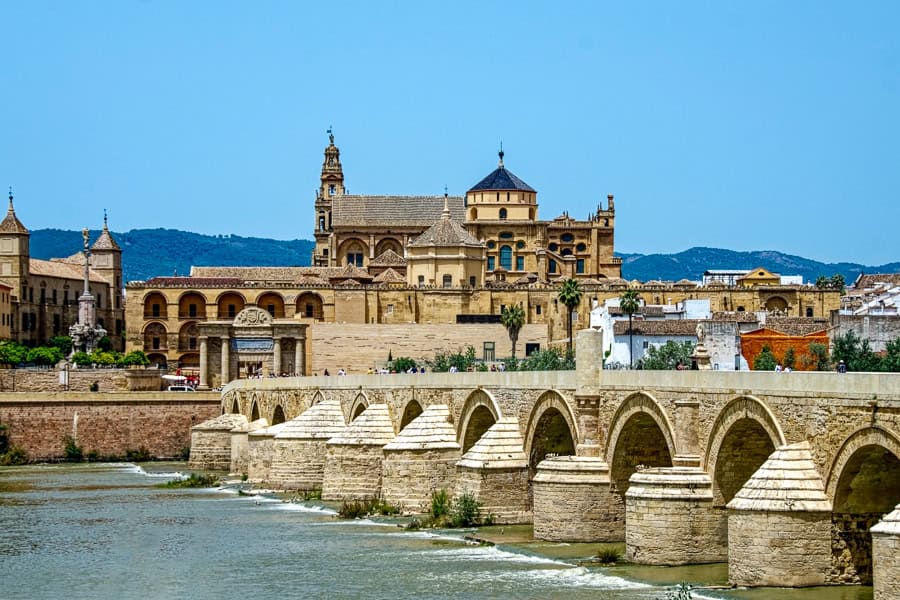
Head back across the bridge and through the Puerta del Puente on your way to the Alcázar de los Reyes Cristianos.
This Mudéjar-inspired fortress-palace with lush gardens, grand halls, impressive towers and Roman mosaics is worth an hour or two visiting. Climb the towers for panoramic views of Córdoba and stroll through its beautifully manicured gardens.While here, check out the adjacent Baños del Alcázar Califal -the partially restored, once luxurious 10th-century bathhouse of the Alcázar.
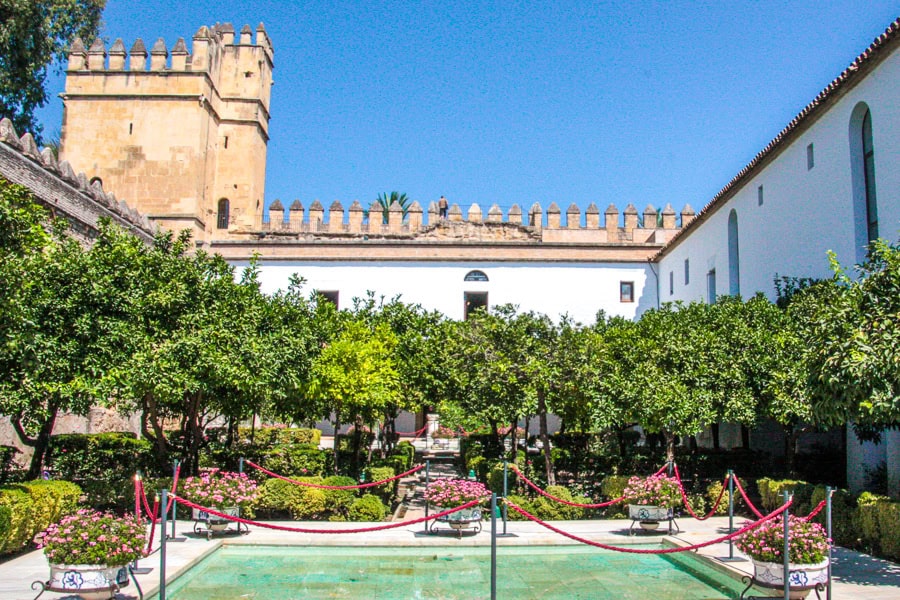
As the evening approaches, head to the San Basilio neighbourhood to explore the famous Patios of Córdoba before strolling through the winding, medieval streets of La Judería (the Jewish Quarter).
Grab a sundowner with a view somewhere like Casa Pepe de la Judería, Hotel Hesperia, or La Taberna del Rio before finding dinner.
Day 13 – Córdoba to Toledo
Highlights: Sinagoga del Tránsito | Monasterio de San Juan de los Reyes | Toledo Cathedral | Alcázar & Military Museum
Total driving distance: appx. 345 km (215 miles)
Total driving time: appx. 3.5 hours
Overnight: Toledo
It’s only fitting that the last stop on this incredible Spain road trip itinerary – Toledo – is another breathtaking World Heritage city.
Nearly 350 kilometres north of Córdoba, it’ll take around 3.5 hours to get to the capital of Castilla-La Mancha. So an early start is advisable if you want to have time to fully explore this fabulous city, perched dramatically overlooking the Tagus River.
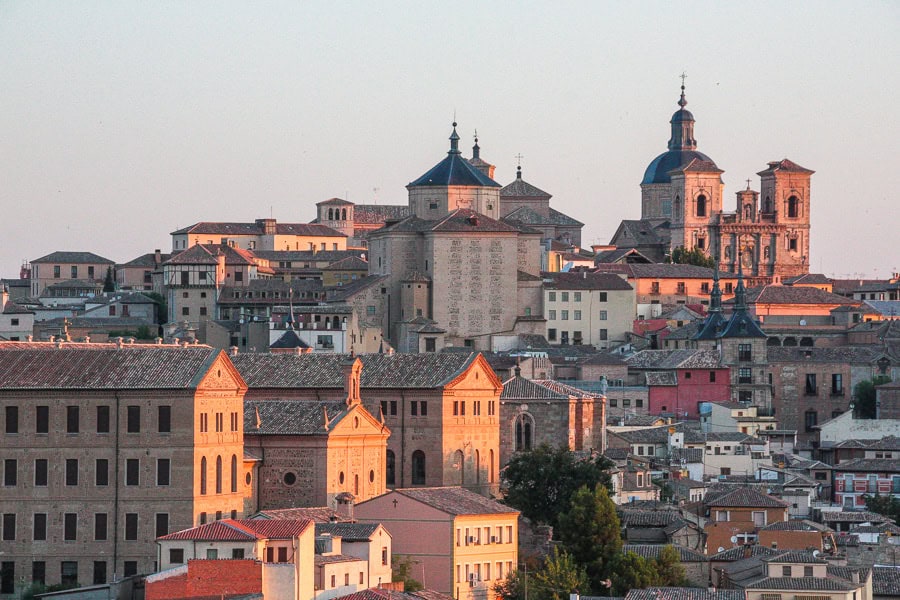
Toledo is another very walkable city. Once you’ve dropped your bags, head to the Jewish Quarter and begin your exploration by visiting the Sinagoga del Tránsito, an intricately decorated 14th-century synagogue that’s now home to the Sephardic Museum.
A few hundred metres up the road, you’ll find the striking, gothic Monasterio de San Juan de los Reyes, a 17th-century Franciscan monastery with ambient cloisters, gardens and hallways.
Find somewhere to fuel up and rest for a bit before heading on to the real highlights of Toledo in the afternoon.
One of Spain’s finest medieval Gothic cathedrals, the Catedral de Toledo has an elaborate interior filled with masterpieces by old masters including El Greco, Velázquez, Caravaggio and Goya, along with a richly decorated altarpiece.
The cathedral’s bell tower offers spectacular views of the city, while the treasury contains the monumental Monstrance of Arfe, a silver and gold masterpiece that has to be seen to be believed.
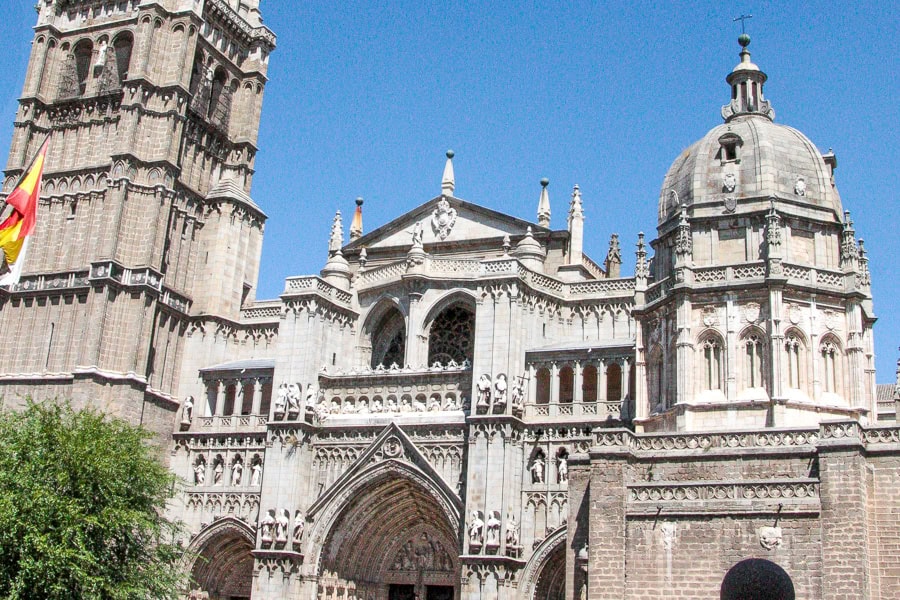
It’s worth heading up to the Alcázar of Toledo, if only for the panoramic view over Toledo’s medieval skyline. This imposing fortress, perched on the highest point of the city, now houses the Military Museum, where you can learn about Spain’s military history through interactive displays, historical artifacts, and exhibitions.
You’ll also find the beautiful Renaissance Museo de Santa Cruz right next door to the Alcázar. It houses a collection with works by El Greco, as well ceramics, tapestries and religious artifacts.
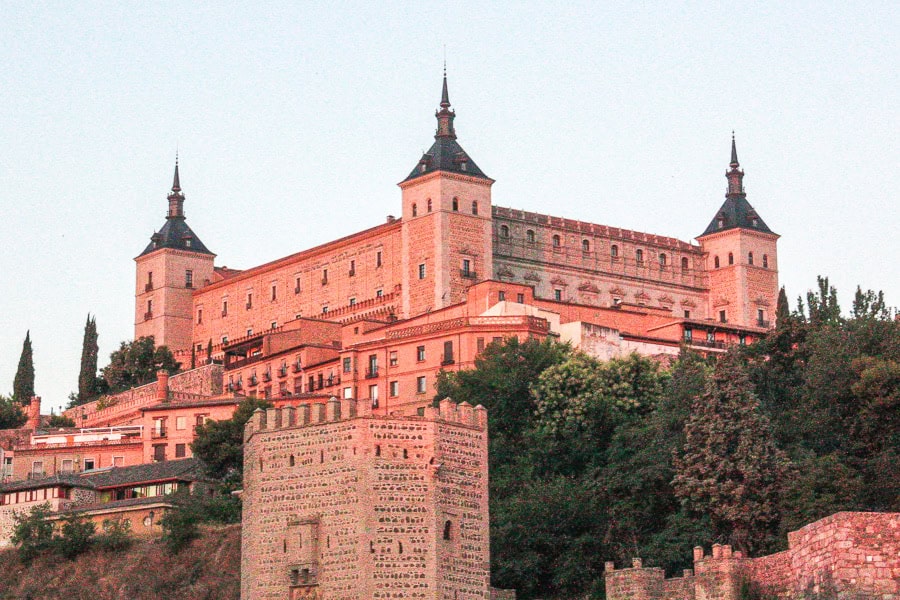
This evening, head to Plaza de Zocodover, Toledo’s lively main square, for a few drinks and one final taste of hearty Andalucian fare.
Where to Stay in Toledo
With exceptional architectural and cultural heritage, and located just an hour south of Madrid, Toledo is a popular destination for locals and visitors alike, and it has a broad range of accommodation options.
We stayed at Hotel Casona de la Reyna, located in a lovely historic building overlooking the Tagus gorge on the edge of town, but still just a 10 minute walk from the centre. Rooms were comfortable, and the secure underground parking on site was very convenient, even if it’s paid rather than free of charge for guests.
The following options also get consistently good reviews:
- Good value: Hotel Zentral Mayoral – spacious clean rooms | good value restaurant | access to old town (via escalators) | on-site (paid) parking
- Mid-range: Parador de Toledo – large, modern rooms | great views | lovely pool | 4km from centre | free parking (which offsets taxi costs)
- Indulge: Entre Dos Aguas Hotel Boutique – tasteful, comfy rooms | old town location | lovely roof terrace | fabulous, intimate restaurant | paid parking garage nearby
Day 14 – Homeward Bound
Highlights: Planning your next visit to Spain
Total driving distance: appx. 85 km (53 miles)
Total driving time: appx. 1 hour
It’s only an hour or so to Madrid Airport from Toledo, depending on traffic in the capital. Plan your departure to allow sufficient time to drop your hire car off and check in for your flight home.
If you have a later flight, you might want to have one final wander around Toledo’s historic centre and grab some breakfast.
For one final, majestic glimpse of Toledo on your way out, we recommend driving by Mirador del Valle, considered one of the best viewpoints in the city.
Time to start planning your next trip to Spain!
Sound like your kind of adventure? If you’ve got any questions about this Spain road trip ask us in the comments below.
If you’re looking for more great road tripping itineraries and adventures, check out our Road Trips page, and our bucket list of 100 ultimate road trips around the world.

OMG what a detailed trip itinerary, will definitely follow Madrid things in my upcoming Spain trip. Thanks
Thanks Santos, really glad you found it helpful. Hope you have a fabulous time in Spain.
your blog is great
Thanks Tyra!
That was a great article, thank you.
Thanks so much, Kisha!